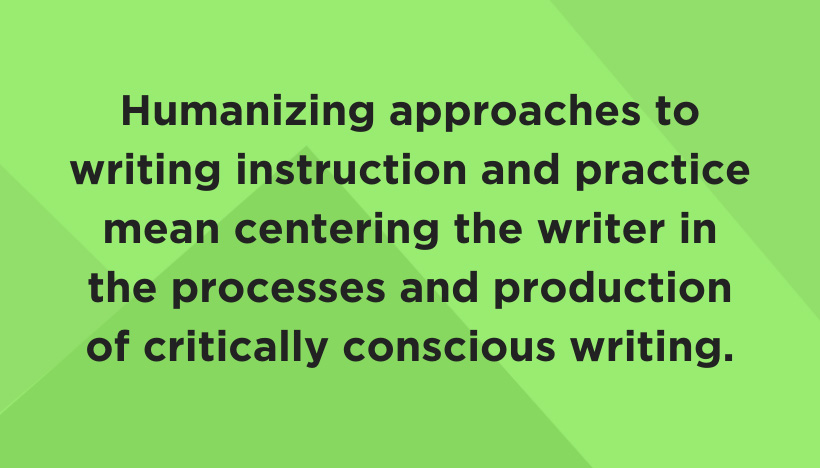This post presents an excerpt from the article “Revealing the Human and the Writer: The Promise of a Humanizing Writing Pedagogy for Black Students” (Research in the Teaching of English, May 2020) by Latrise P. Johnson and Hannah Sullivan.
Recent research in writing with adolescents in out-of-school spaces provides insight into how young people learn to use writing to author their own lives. However, English language arts classrooms focus on correctness, form, and removing oneself from the texts composed in school. For Black students in particular, these expectations for writing dehumanize students, decenter their voices and contributions to intellectual discourses, and invoke deficit perspectives about their writing abilities and linguistic identities.
Using a critical stance on place, literacy, and humanity in order to examine how the literacy learning and practices of ELA classrooms/schools might (de)humanize and (de)culturize Black students, this study examines the writing pedagogy of a professor who taught a semester-long creative writing class for students at West High School.
Through a humanizing approach to teaching writing, the professor and students engaged in writing and being in ways that honored—as well as centered and supported—their individual, cultural, and writerly identities. This article offers ways that teachers of writing might tap into Black intellectual traditions and invite students to use writing as a way to connect to what they do and learn while at school.
Historical perspectives of Black conceptions of literacy position Black people as demanders, creators, funders, and maintainers of educational institutions that have (a) provided literacy for all; (b) apprised individuals of and prepared them for the dominating culture’s institutions; (c) counteracted the pernicious and venal images of African Americans prevalent in popular culture; and (d) engendered group solidarity and commitment to uplift (Harris, 1992).
These perspectives are reflected in texts that historicize and imagine the lives of Black people, as well as in the contemporary composition of authentic portraits of Black people that challenge monolithic, dominant, and damaging narratives. The production and centering of such texts represent what is possible for teaching writing to Black youth, in that these texts serve as a “re-appraisal of . . . aesthetic values . . . [that are] less influenced by the dominant standards” and allow Black youth to “be taught with real conviction the beauties of [their] own [lives]” (Johnson, 1936). These texts also provide models for how writing has been used to add the voices and perspectives of Black people to bodies of knowledge that have historically ignored their contributions.
Therefore, a humanizing writing pedagogical stance begins with the notion that students’ knowledges (which encompass their collective and individual histories) are at the center of what they are expected to know and do while at school (Bartolomé, 1994; Donnell, 2007).
Thus, a humanizing writing pedagogy provides a lens to view Black students’ individual lives and creates opportunities for them to make personal, critical connections to a world where they share collective struggle related to the “circumstances of race status” (Johnson, 1936). With regard to writing instruction and the production of text, humanizing pedagogical processes require that pedagogues enact critical practices that interrupt normalized literacies and dominant ways of knowing and being.
For instance, the full development of a writer depends on understanding oneself in relation to one’s world (Johnson, 2017). That said, humanizing approaches to writing instruction and practice mean centering the writer in the processes and production of critically conscious writing—and, in this case, in ways that involve Black youth in the meaning-making that is part of a rich literary tradition.
Indeed, Black people have historically “needed literacy in order to acquire freedom and power” (Harris, 1992, p. 278). And it is that history and re-centering of Black culture that is integral to humanizing writing pedagogies for Black youth as they (1) recall forms of literacy that privilege and are contingent upon students’ sociohistorical lives, both proximally and distally; (2) are grounded in literate histories and traditions of Black people; and (3) invite Black students to compose and add their voices to various bodies of knowledges.
Read the full article by Latrise P. Johnson and Hannah Sullivan.
Latrise P. Johnson is an associate professor of secondary ELA and literacy at the University of Alabama.
Hannah Sullivan is an assistant professor of Spanish at Charleston Southern University.
It is the policy of NCTE in all publications, including the Literacy & NCTE blog, to provide a forum for the open discussion of ideas concerning the content and the teaching of English and the language arts. Publicity accorded to any particular point of view does not imply endorsement by the Executive Committee, the Board of Directors, the staff, or the membership at large, except in announcements of policy, where such endorsement is clearly specified.

